Video game development can take years. Some projects are incredibly ambitious, hit various roadblocks along the way, or both. However, sometimes there's a perfect storm of circumstances leading to more impromptu projects emerging from the aether. With Pompom: The Great Space Rescue, solo developer Willem Rosenthal started with a game jam project created in just two days, and two years after that decided to flesh out the idea following the outbreak of a global pandemic.
Game Rant spoke to Rosenthal about Pompom's origins and design inspirations, as well as his ongoing work on Go Go Kudamono! Interview has been edited for clarity and brevity.
RELATED: Andro Dunos 2 Developer on The Game's Release to Dreamcast and Other Platformers
Q: How and why did you get into game design?
A: I've been interested in video games forever. Almost all my earliest key memories if I think back to when I was really little were somehow tied to a game. I remember seeing an older kid playing Final Fantasy 7 before my parents let me have consoles. Games left a huge impression on me, they've always kind of been there.
Then I went to art school and thought I was going to be an animator. When I was there, I decided animation was sort of depressing; many hours drawing the same thing over and over again. I wasn't sure that's the angle I wanted to go, so I turned my interest to video games and started teaching myself programming on the side. Then, for my senior thesis I decided to make a video game. After school I felt like I'd taught myself enough that I could be in the industry, so I forced my way in from there.
Q: What did you do to start breaking into the industry?
A: I started by making games myself. I taught myself ActionScript and was making games in Flash, so I guess my hope was I would make something really impressive and get some game studio to notice me.
Then I got a lucky break. A one-man indie team working on a game called Realm of the Mad God in Silicon Valley (I was living in Berkeley at the time) put out a listing on Craigslist for a game designer who could both design and do art. I guess that's a rare enough combination that I didn't have much competition, so I managed to snag this job and go on from there.
Q: One reason I wanted to talk with you is I played a lot of Realm of the Mad God back in the day, so when I saw that on your resume I thought it was really cool.
A: Yeah! I was on Realm of the Mad God back before Kabam bought it, don't know how much you know about its history when it was just Wild Shadow Studios. I took over all the design-related stuff, I made a lot of the cool dungeons and expanded what the game was early on. Then maybe six months to a year after I was on, it got bought by Kabam and I moved there. I was in a much bigger part of the industry after that.
Q: What did you take away from that and other early experiences in the industry?
A: In order to make games, especially if you're on a smaller team, you have to understand so many facets of the industry. It's not as simple as, "I can draw and program and design," you need to understand schedules, meeting deadlines, drawing up documentation. Those early jobs gave me a ton of hands-on experience in terms of something like having an idea but needing to present it to someone.
I guess these sound like basic real-world skills for any kind of job, but I went to art school and they don't teach you that.
Luckily I was good at communicating between different disciplines from the start because I worked in multiple disciplines. It was a huge thing, especially when we moved to Kabam and there was a bigger team. If we wanted to implement a feature it'd also need UI designs, for example, which taught me to draw up wireframes and bring them to the artist so we could test how it's going to be.
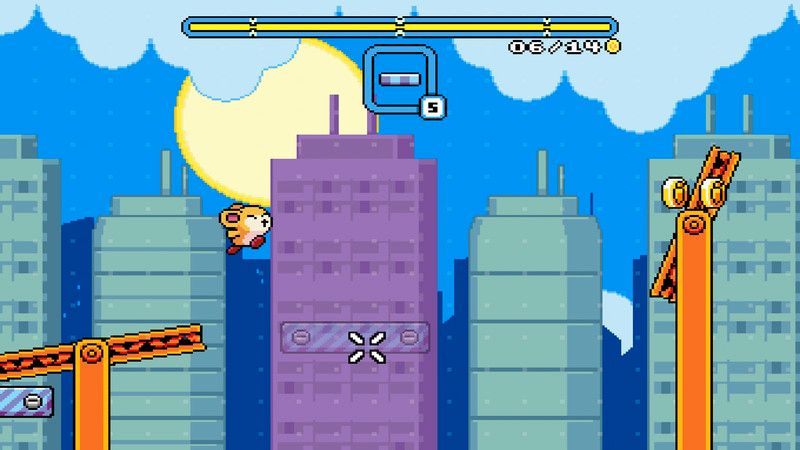
Q: If going to art school didn't give you a lot of those "real-world" skills, what did you take away from it?
A: I guess art school teaches you to follow your passions, which is pretty important for game development since it can be kind of grueling and there's a lot to do. You have to be really passionate because it's so many hours of work and long projects that take years to complete.
That and developing my art sensibilities, I had a lot of great teachers who encouraged me to develop my own art style. Just the fact I majored in illustration and they let me make a pixelated video game as my senior project speaks a lot to that, because my main classes were things like magazine illustration.
Q: So you were with Kabam, and I believe a few other companies before starting your own, is that right?
A: Yeah, so when I was at Kabam I was on a team with Thomas Uster who became a really good friend of mine. I came up with the idea for a Tamagotchi-style game I wanted to make for iPhone that we ended up calling Pakka Pets. Tom and I quit Kabam to start a company we called Proto Games and made Pakka Pets together, and that was a pretty big project. We worked for maybe two years to release, and then another two years to make a big update that was like a sequel. That was my last big project.
I made a few kind of small games on the side, but they were just for fun.
Q: What was the difference making your own project versus jumping on a pre-existing idea with Realm of the Mad God?
A: It was much more my own design, which was really cool. I love Realm of the Mad God and it was fun to work on it, but I don't play many multiplayer games. Also, even though I got to heavily impact its aesthetics, it still wasn't my art style. Plus I wasn't in control of the basic design and schedule, so it was very freeing being able to make my own project; something I really wanted to exist in the world.
RELATED: Nintendo Switch Online N64 Games With Multiplayer Modes
Q: What was the drive behind Pakka Pets?
A: Tamagotchi was a huge thing for me, it's probably the fad I cared most about when I was a kid. I have such a strong memory of going to the store to get my Tamagotchi and carrying it around everywhere. It felt silly that we have these smartphones we carry around all day, which is the perfect vehicle for something like that, but there wasn't really anything to fill that void. I really wanted to make something that was a better version of the childhood experience I had.
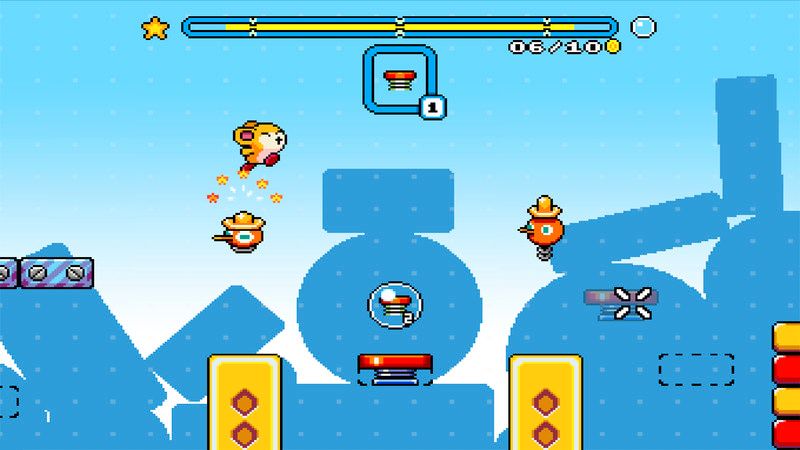
At the time I was also really into Animal Crossing, so a lot of that inspiration rolled into the game as well.
Q: Judging by Pompom, I'm sensing a theme with cute animal mascots for your work.
A: I guess it worked out that way, though that's not necessarily something I thought too much about.
The Super Nintendo is probably my favorite console of all time, and I really like that Nintendo style from back then. That includes games like Super Metroid which weren't that cute. But I like bright colors; I am a big fan of cute, not saccharin-sweet art styles like Super Mario World. I think animals go hand-in-hand with that.
Q: After your work on Pakka Pets, you participated in the 2018 Game Maker's Toolkit (GMTK) Game Jam.
A: Ah, you mean when I made the jam game Pompom grew out of.
Q: That's what I was leaning toward, yep.
A: That was a few years ago, I'd already started work on Go Go Kudamono!, a big ongoing project. To segue real quick, I've taken a break for the last year or so after COVID hit. I have this project that's a massive, ambitious undertaking as a solo dev, and I was feeling burnt out. I wanted to take a break and work on this game jam game I was inspired by.
I was still working on Go Go Kudamono! at the time, and I took a weekend to do the GMTK Jam. Pompom grew out of that.
Q: So tell me a little about where that game jam idea came from.
A: The premise of the jam was taking a staple genre and removing one of its main mechanics. I was thinking about trying to make an action game where you weren't in control of the main character. I believe at the time IGN came out with a list of great games for Game Boy and SNES, and I was really taken with Donkey Kong '94 - a Game Boy game that turned into the Mario vs. Donkey Kong series.
I never played it, but I was looking into and thinking about that. Also about Mario & Wario on Super Nintendo, which is much closer to what Pompom ended up being. I was thinking about these puzzle spaces and wondering if I could take puzzle mechanics like in Lemmings or Mario & Wario and turn it into an action experience rather than a thoughtful one - not that there isn't a lot of thought put in here.
Basically I thought it would be really exciting to build a level as you go, place blocks under a character's feet.
For any game jam game I work on, I'll usually come up with some sort of base idea and then experiment with it as I go. I'd seen games like Lemmings where you're placing blocks and influencing a character who moves on their own, but I'd never seen it where there's a rushing time-limit sensation. Once I hit on that, using a flow experience to make your way through levels rather than pausing or having a more stilted sense like Mario & Wario, incorporating that feeling was really important.
Q: You said you've done multiple game jams?
A: That was my first game jam, but I've done more since. The last one I did was another GMTK Jam, I made a pinball game called Mr. Flipper where you control the flipper in a 3D pinball space. You can plop yourself down to be the flipper, but also jump up and run around on little feet.
Q: How useful would you say the game jam format is for fostering ideas?
A: I think it's great, you never know what you're going to come up with. Like Walkie Tori, I made it in a game jam and haven't been able to get it out of my head. That's why when the pandemic hit and I felt like I needed a break from Go Go Kudamono!, this was what I turned to. It clicked that this could be a full-length Super Nintendo game.
The flipper game I'm equally happy with, but it's not something I'd choose to expand. That's the fun of a game jam game; it gives you the chance to try something and polish it to the point you can see how fun it is. Maybe it turns into something amazing you can't get out of your head, maybe it doesn't.
The beauty is you don't have to worry about that, whereas when you start a project that wasn't from a game jam there's a lot more pressure. You're saying, "This is an idea I've had for a while, I want this to pan out into a game I can sell." It's really freeing with a game jam game, all you can think about is you have three days to come up with something that might be cool. It could be a gimmick, a joke, or just something you want to try. You don't have to worry about sellability, which can put you into a box, but it still has the potential to be something that hasn't existed before.
RELATED: Tinykin Developers Discuss Journey from Game Jam Project to E3 2021 Showcase
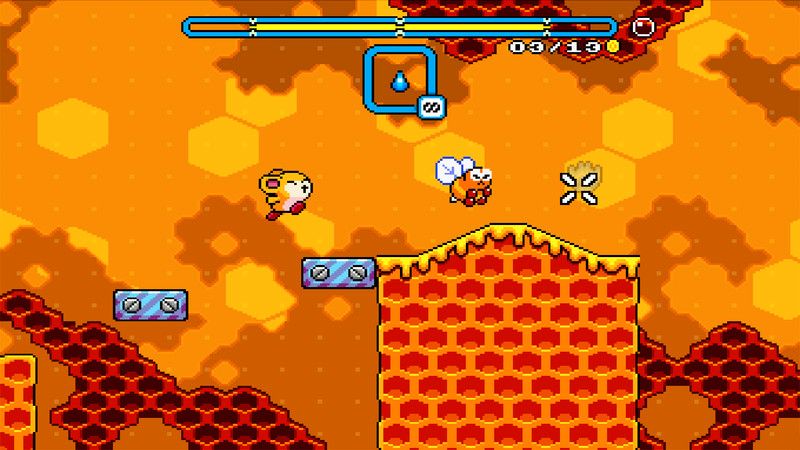
Q: So do you see Pompom as more of a "sellable" idea? Will it help bankroll your other game?
A: That's the plan. We're releasing it on PC and Switch to start, but I hope it can do well.
To me, I think it would fit in really well with the early Super Nintendo library, and those are my favorite games. I can only speak for myself in this way, but I try to make something where if I saw it on the shelf I'd want it. Hopefully it can help pay for me to keep making games.
Q: How much did you expand upon the idea going from game jam to full project?
A: A lot. I really like the ethos for these kind of games where you make it exciting by throwing in as much content, as many unexpected things as possible. I thought a lot about Yoshi's Island on SNES, which is a game where pretty much every level introduces a new mechanic or enemy that behaves different from anything else you've seen. I tried to do the same for Pompom.
Q: How long is the game overall?
A: The demo is about a seventh or eighth the length of the game. It's hard for me to judge gameplay time because I could probably beat it in a couple of hours, but the demo alone can take people up to an hour to beat. It depends on how much you die.
I'm tuning it. I made the demo easier, and in just a week or two I've got a lot of feedback forms coming in. My goal is that you die a couple of times in every level, I don't give you lives so you run out. You're meant to figure it out, especially since I'm throwing something new at you in almost every level. Also because the game design as a whole is pretty new. It takes people a lot of time to get used to this kind of platformer.
If you get a new Mario game, you're coming into it with all that Mario experience you've had, and all other platformers cross over to one another. This is kind of a new way of controlling a game, and it's an action game so it requires reflexes and quick thinking. I like to have people die a few times, but I never want it to be frustrating.
We're probably looking at between four and seven hours to beat the whole game, depending on your skill level.
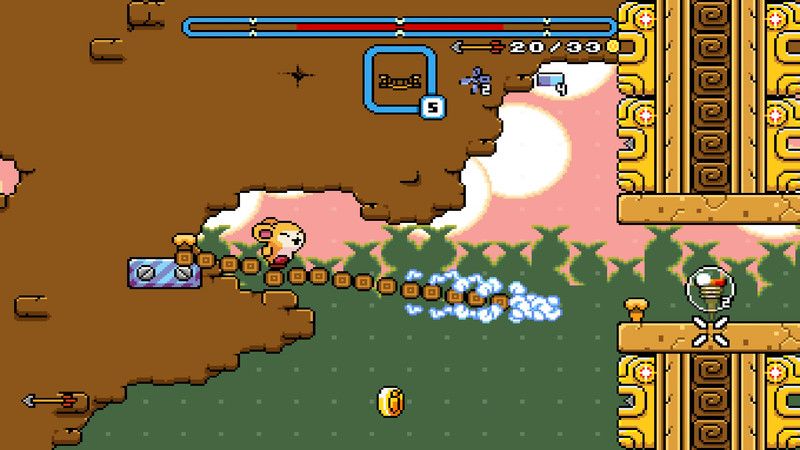
Q: Are you expecting or interested in seeing a speedrunning scene around the game, considering it has that kind of focus on mastery?
A: It's something I'd be curious to see. I'm considering adding in some special abilities that foster it, giving your character the option to speed up in places. But my first priority is making the game as well-balanced and fun as possible for everyone. I think I always start by striving for, "If this was a Super Nintendo game in 1994, what are the features it would need? What would it take to be a game Nintendo would be proud to put out?"
I think a lot of companies and game developers out there are trying to make retro-style games, but a lot of those games fall into the trap of being about "being retro" rather than just being retro, if that makes sense. I'm not making cheeky references in this game about putting the cartridge in the slot, I don't want any experience that wouldn't have been there if it was made in the early 90s.
I'm focusing on that first, and that goes for things like speedrunning. I'd love to put in more features that let people play it in new ways, but I'm trying to keep the experience as pure as possible first.
Q: One thing that didn't show up much back then was accessibility options. Are you planning on adding any for people who might struggle with the action gameplay?
A: I'm definitely not a believer that a game which wants to feel like it's from that time period needs to strip away modern conveniences. There is a Super Nintendo mode setting, which puts the game in 4x3 and stretches it like it were on a CRT, but that's not on by default for a reason. I expect people will want a modern experience.
Same thing for accessibility options. The game's not that complicated so there are also simple things like you can change the screen shake amount, which I know makes some people nauseous. There's also difficulty settings, like you can give yourself substantially more freeze time. That's something I want to playtest and see how people feel, I'm definitely open to putting in more options that make it easier to play.
The goal was not to make a punishing experience that only expert gamers can make it through, and that extends to accessibility.
Q: It's not the Dark Souls of platformers.
A: Exactly, yeah. Although I do very much love that series and feel like they shouldn't have a difficulty option - but that's a different style of game.
Q: What are the biggest challenges of designing around a character who moves by themselves?
A: Probably the biggest challenge is coming up with things to interact with. Like I said I tried putting new mechanics in every level, but if you think about the kind of mechanics a normal player character can interact with; for instance a balance beam; they're interesting because you can run left and right on them. A balance beam is not very interesting for a character who will run straight across it no matter what. You can make it interesting by dropping other objects, but you have to take into consideration that anything pre-existing isn't guaranteed to be useful.
RELATED: Japanese Gamers Vote On The Most Frustrating Video Game Ever
There's been a lot of challenges in coming up with the additional mechanics to make them work around this character who behaves so differently.
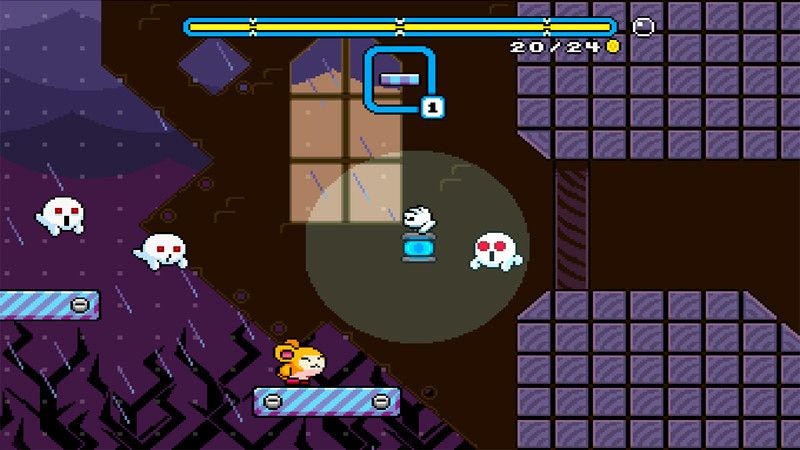
Q: Are there any ideas you've come up with that you're particularly proud of?
A: I really like all the boss battles in the game. They're all really unique. Even the first boss in the demo is great showcase for how different a game like Pompom is to anything else. At first you feel like you're just running to the right, but then when you're locked in a space with this enemy and he's interacting with the blocks the same way that Pompom is, something clicks. It's a new experience.
When I developed that first boss, that moment was pretty exciting to me to see how the possibilities would open up.
Q: How many boss battles are planned for the game?
A: There's a boss at the end of every world, and there's eight worlds.
Q: Boss battles are a good segue to ask how you came up with Pompom's narrative. It's a simple plot, but how difficult is it to imagine one thing that ties it all together?
A: I kind of started with the world and levels, and then wanted to figure out something cute that pulls it all together. I landed on Pompom because I used to like Hamtaro as a kid, and I was thinking about how he's a character that runs through a maze as a mouse or hamster would. From there, you extrapolate. What's the enemy of a hamster? A cat would be natural, so they became the villain. Then you're travelling to these different worlds, so space makes sense.
Once you have all these pieces floating around, you just connect the dots. Try to come up with something that has the right feel.
I also like, even if it's not a very story-based game like Pompom, having a motivation so you understand why the character is doing something. Saving someone you love is obviously a great motivator.
Q: I hope you know I had Hamtaro written in my notes, I used to play all the Game Boy-era Hamtaro games.
A: Yeah, that franchise is really cool.
Q: So you mentioned you're primarily by yourself, but you have worked with a composer and illustrator?
A: Exactly. I work with Lynn (@Chordbug) for all the music, she's an amazing composer. Pretty much everyone I work with is just someone I found on Twitter, because it's hard to find people who have just the right style. I spend a lot of time cruising Twitter and looking for people who could be cool to work with one day. I have a bit of a backlog, so if I ever find the right person for the project I'm excited to bring them on.
Lynn did an amazing soundtrack, and then I worked with Bruno Leni (@atkombi) for the cutscene art. He also did the promotional art for the game. That was kind of cool too because it was a collaboration, so I did sketches for everything and storyboarded it out. Then we'd go back-and-forth, working to improve and get to that final part. We also have a bunch of cutscenes not yet shown that will be cool for people to see.
I also work with Ali Cedroni (@AliCedroni) from NokNok, they did all the sound effects in the game.
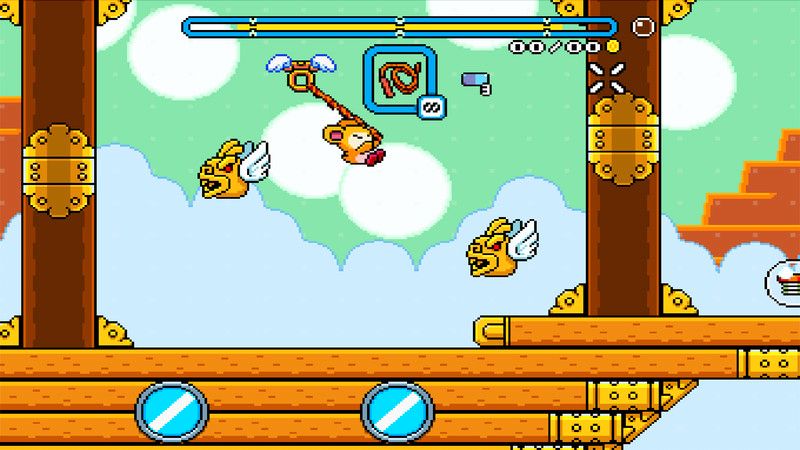
Q: What is it like collaborating with someone to get your idea out there, even taking into account what you said about curating collaborators?
A: If you find the right person it's great, and it's easy. That's why I spent a long time picking the right people for this. Lynn was already into Super Nintendo-style music and is just the right composer for the job. When you find the right person, you send them inspiration and say, "Here's a video of me playing this level." Nine times out of 10 they send you back exactly what you want.
Q: And I believe you also have a publisher, right?
A: Yes, I'm working with PID Games to publish the game, they're really cool.
Q: How did you get connected up there?
A: Through Twitter and email I've been talking with them for a while, including for some of my other projects. Since I put Go Go Kudamono! on the backburner I'd been loosely talking with a couple of publishers.
Once I got Pompom to a place where it's basically done, minus polishing and porting, I started reaching out. They were really excited about working on the game with me.
Q: So you recently took part in Steam Fest. Can you tell me a little about why, what that was like?
A: The main idea is to get visibility, to get feedback. I've never made a demo before for any of my projects, so that was also an interesting experience - taking the game and boiling it down. I pulled levels from different parts of the game and reworked them to make sense early on, for players who don't have hours of practice. That was a really great experience, working on polishing a section of the game that finely.
It helped me build a roadmap, because the game is content complete right now. What's next for me is to do what I did for the demo at a larger scale. Playtest it, polish it, get other people to test it. Make sure the experience from the beginning is the right difficulty, that every level is interesting and pulls you along to the next in the right way. Doing that in miniature with the demo helped.
Then, of course, getting it out to the people, getting attention and a spotlight on the game has been tremendous.
RELATED: Steam Next Fest Will Feature No Man's Sky Developer's Latest Game
Q: What's been the general reception to Pompom?
A: Plenty of people don't write any feedback, but the people who do have been really positive on it. I added a recent feature after launching the demo about a week ago, I call it "frustration feedback." If you die a few times it pops up a thing to ask if the area is good frustrating, bad, challenging or not. I've gotten a lot more feedback from specific parts of the game from that.
Most people, pretty overwhelmingly, respond to that saying they like the challenge. That's been really nice to hear.
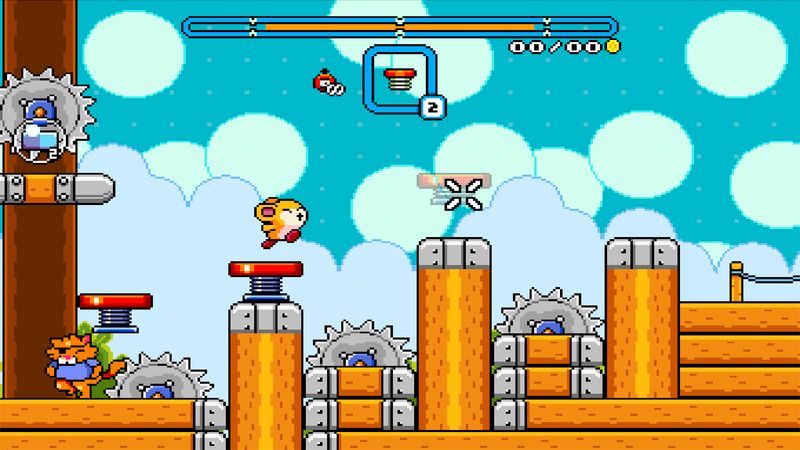
Q: So if you're content complete and seemingly going in the right direction based on feedback, is there an idea when you think you'll be done?
A: We're hoping to launch in early 2022. I don't have an exact date yet; I need to port the game to Switch. Right now it's a very mouse-heavy game, so I want it to be comfortable with a controller. I've budgeted a decent amount of time to work with those controls, it's probably a big challenge coming up.
I also need to localize it, try to get it in as many languages as we can.
Q: So you're doing the Switch port yourself?
A: That's the plan.
Q: Have you started that process? What's the difference working on that system?
A: I have not. The Switch dev kit is in the mail, so as soon as I get that I can start looking into it. But I'm working in Unity and that makes it pretty easy to do these sort of things. Larger companies working on complex games have more to deal with because they're maybe going from PC to a less powerful platform, and need to tone down graphics. Pompom can probably run on a graphing calculator, it's a Super Nintendo-style game.
I don't need to worry much about that. The challenges for Switch are going to be making sure the controls feel great, probably implementing specific needs like hitting certain buttons to bring up the right menu. Also small things people might take for granted, like making sure button prompts all say the right button type.
Q: You've said this was a side project, but is there anything you've learned that you'll take into Go Go Kudamono!?
A: A lot of my design ethos is the same between both games. They're both very much based on wanting to create as much content as possible so I'm not recycling. I think I've gotten better at developing things quicker and adding new features. As in Pompom, with Kudamono I want to have lots of different parts of the game that feel unique from one another.
Every year that I spend programming, I'm a better programmer just in the way I think about development and structure things, how cleanly I write code, organize things, make art. You keep getting better the more you practice at it.
Q: Are you jumping back into Kudamono full-on when you're past Pompom?
A: That's the plan, as soon as Pompom's done I'd like to get back to Go Go Kudamono! Pompom started as a little side project and I wouldn't call it that anymore, it's a full-sized, beefy game. One of the challenges to starting a project is you get so excited about it that it's hard to keep it small.
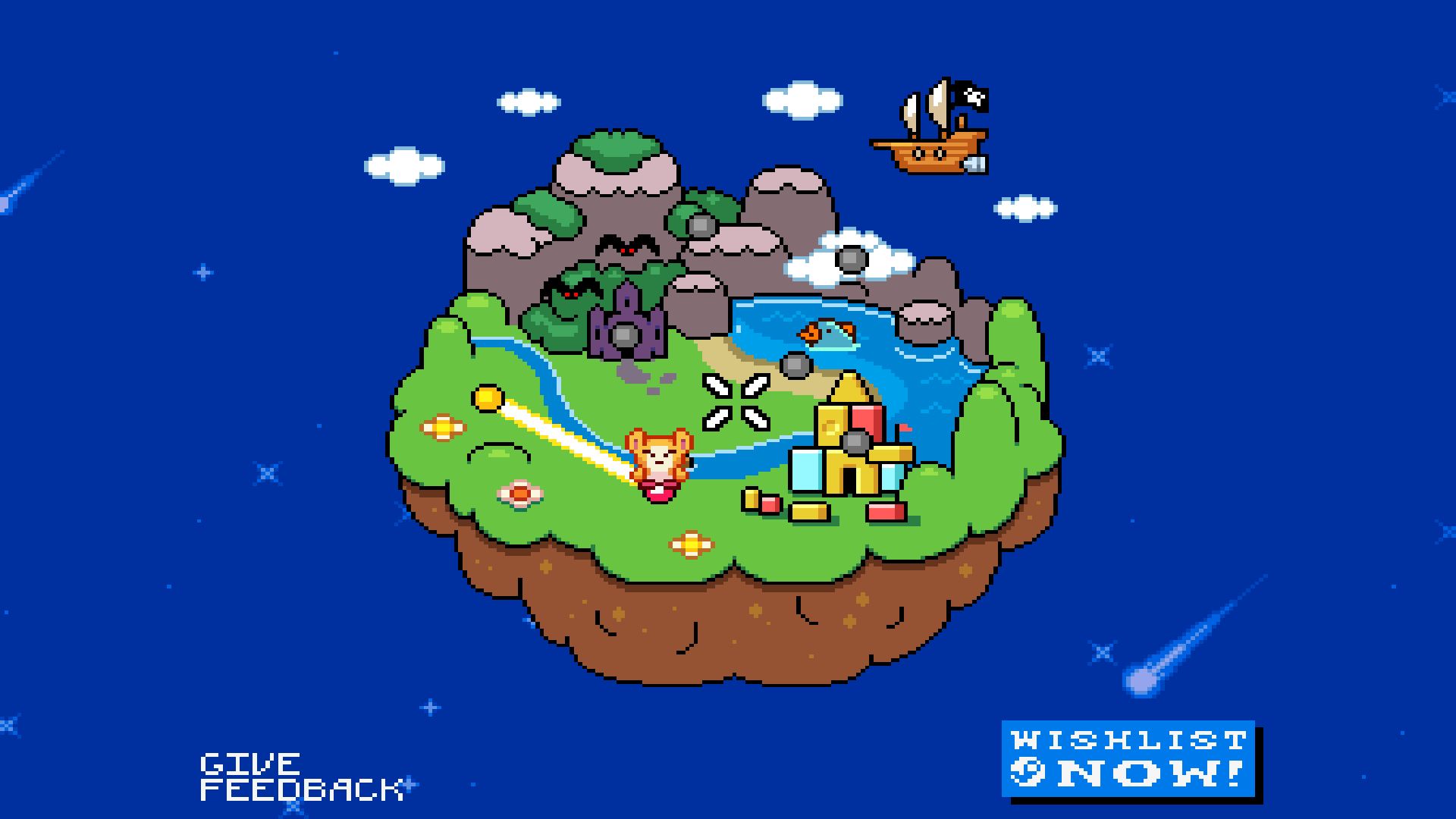
Q: Since that's also on the horizon, you want to give your elevator pitch for that game?
A: Sure, Go Go Kudamono! is kind of an action-arcade RPG. It's not really an RPG - I wanted to capture that RPG feel from the Super Nintendo/PlayStation-era where you're going to different places and there's a story that interlocks it together. Like you're exploring a whole world. That's what I love from those old RPGs.
But I removed all the "RPG elements," you don't have stats or level up. It plays like an arcade action beat-em-up, mixed with Pocky & Rocky. The goal was mid-to-late 90s arcade art fidelity, but with a scope that feels like a Final Fantasy game.
I think it hasn't really been done before because it's an insane amount of work. The reason why beat-em-ups tend to be like 30 minutes long is because of the art fidelity. Trying to bring that to a bigger experience has been a challenge, but I think it's coming along really well.
The story is pretty crazy, you play as a lime who's the prince of the fruit kingdom. There's this war happening where the insect kingdom is taking over other nations. It's a bit inspired by Germany in World War 2, when I started the game I'd seen Churchill (2017), a movie about resisting the spread when Germany was taking over Europe bit by bit. Kudamono has some political moments and a negotiation mechanic, you have to get leaders to be on your side.
Q: You were working on that for a while before this. Do you have an idea of what the timeline might be on finishing it?
A: I'd say there's a year, two years left in development. It's pretty hard to tell, very much a moving target right now.
Q: Is there anything else you might want to add?
A: Like I said it started off as a side project that grew out of a game jam game I did for fun, just because this idea felt so cool and I'd never seen it executed like this before. It's hard for me to put down an idea when I get a feeling like nobody's done this. It started really small, and I'm proud that it's grown into something the size of a game you'd find for $60 on the Super Nintendo in the 90s.
Q: I'm assuming this won't cost $60 today, though.
A: No it won't cost $60. Don't think we've landed on a price yet, but it'll be whatever you'd imagine a downloadable Super Nintendo-looking game to be. My publisher probably wouldn't like it if I just threw out some numbers.
[END]
Pompom: The Great Space Rescue is in development for PC and Switch. A demo is available now on Steam.
MORE: Cris Tales Interview: Dreams Uncorporated CEO Talks Colombian-Inspired JRPG
Source: Steam

